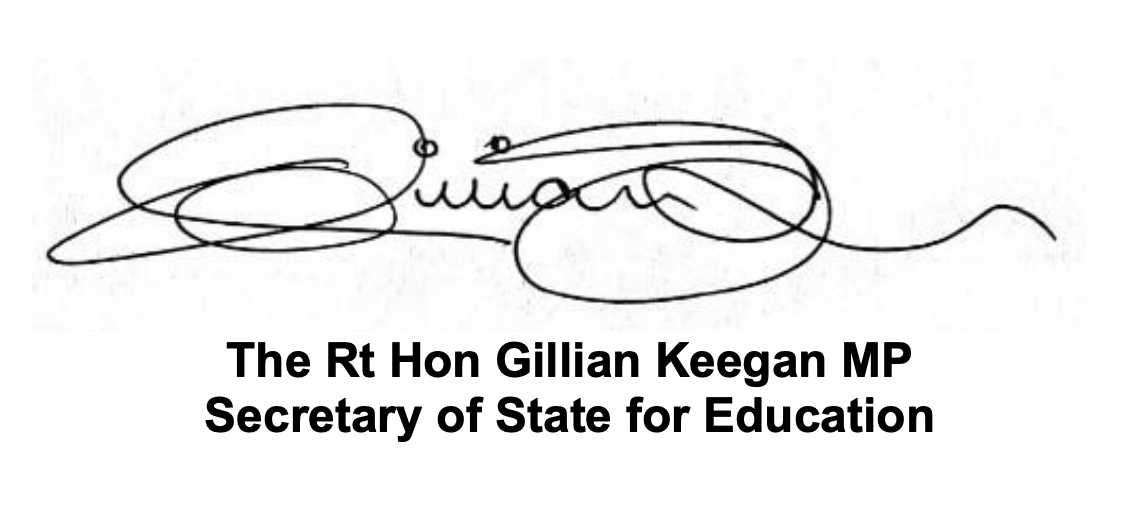When government departments publish things on the day that Parliament rises for Easter recess, they’re usually trying to bury bad news.
So-called “take out the trash day” (named after a notable episode of the West Wing) has brought all sorts of goodies over the years, but we can’t remember DfE’s annual funding letter to the sector being one of them.
The main text bit of last year’s letter – signed by both Nadhim Zahawi and Michelle Donelan – weighed in at 2,252 words. This year’s effort – which must have been using the same template because the Chrome tab says “MD Letter” – is 1,819. And isn’t Gillian Keegan’s signature a delight:

If you’ve been following the Industry and Regulators Committee inquiry into the work of the Office for Students you’ll be aware that one contentious point has been the overall volume of ministerial guidance letters flowing from DfE to OfS.
The old funding council norm was a single letter each year, setting out the funding envelope for the year to follow and offering advance warning for the years ahead. The new model – well:
- 2018: four letters
- 2019: three letters
- 2020: four letters
- 2021: ten (10) letters
- 2022: three letters
- 2023: two letters so far.
The latest entry is naturally nothing like as exciting as it used to be in the pre-9k fees days, but this is still a budget of almost £1.5bn (and almost half a billion in capital) that DfE gives to OfS to disburse on its “strategic priorities”.
So is DfE trying to hide something on “take out the trash day”, and if so what is it?
Maintaining the pie
On the top line, the recurrent grant has gone from £1,397k in 2022-23 to £1,454 next year – which is a 4.08 per cent increase, and so significantly less than headline inflation – although more than the miserly 2.3 per cent increase that minimum maintenance loans are being uplifted by. This doesn’t stop DfE trumpeting the biggest increase in SDP funding for a decade – but it doesn’t look half as good when you move beyond cash terms.
That said, the chunk of this to go on student financial support – the “magic money twig” that used to be all about getting on and is now about students being hungry and cold – is to be frozen in actual terms, which of course means an even bigger real terms cut for a pie that is by definition required to be sliced between more students than ever at risk of dropping out.
Keegan says that the amount to be allocated is “in light of continuing cost-of-living pressures”, which is a bit like saying “in light of how cold it is, I’m maintaining sticking ice cubes down your shirt”.
Similarly, funding for UniConnect is to be “maintained” at £30m, as is its rounding-error £15m allocation for student mental health which, laughably, is supposed to do everything it did last year (the wording is pretty much identical) only with “provide counselling services for students” added.
Laundry lists
Receiving uplifts within the envelope this year are high-cost subjects – an extra £50m for programmes that support the NHS and wider healthcare policy; science, engineering and technology subjects; and specific labour market needs (price groups A, B and C1.1) and a new degree apprenticeship development fund, worth up to £40m over two years, to support projects with the greatest potential to diversify growth at L6, by supporting providers to deliver degree apprenticeship provision for the first time; support existing providers to deliver a wider range of provision (basically L4 and L5 courses); and improve access to degree apprenticeships.
It’s another example of almost certainly not enough cash to achieve a long laundry list of objectives ostensibly to cheer a tweeting minister up. See also £16m in formula funding for Level 4 and 5 provision, and a miserly £5m (down from last year!) on preparations for the modular LLE offer (on which we can only point them to Rachel Sandby-Thomas’ comments on the sheer cost of those preparations).
Funding for “other” subjects, those outside of A, B, and C1.1 is to be frozen in cash terms – in other words a huge real term cut for studio-based arts provision. Everything else not explicitly mentioned in the grant letter will also face this hefty real-terms cut.
Offsetting some of the increases, the £5m for Ukrainian hardship is now history, and specialist provider funding is to be frozen at £58m. £5m is to be kept in the back pocket (presumably so that ministers get to announce a lengthening of the magic money twig at some stage) and what passes for a capital budget these days is as was announced l;ast year – £450m.
Levering up
So no smoking gun, no big surprises but also no real good news in there either. The truth is that this really is small beer when viewed in the context of the overall subsidy for higher education attached to the loan scheme – and is pretty much pocket money for ministers that need to say they have a hand on at least something resembling a lever.
Interestingly, DfE is currently recruiting a new £100k civil service post for the person who will have oversight of the SPG – and will also have responsibility for other recommendations in the Augar Review “including student finance terms and conditions, recruitment limits and the treatment of foundation years amongst other matters.”
It’s a reminder that while for the time being ministers have little control over what is spent, and who and what it is spent on, they still very much would like some of that control back.













